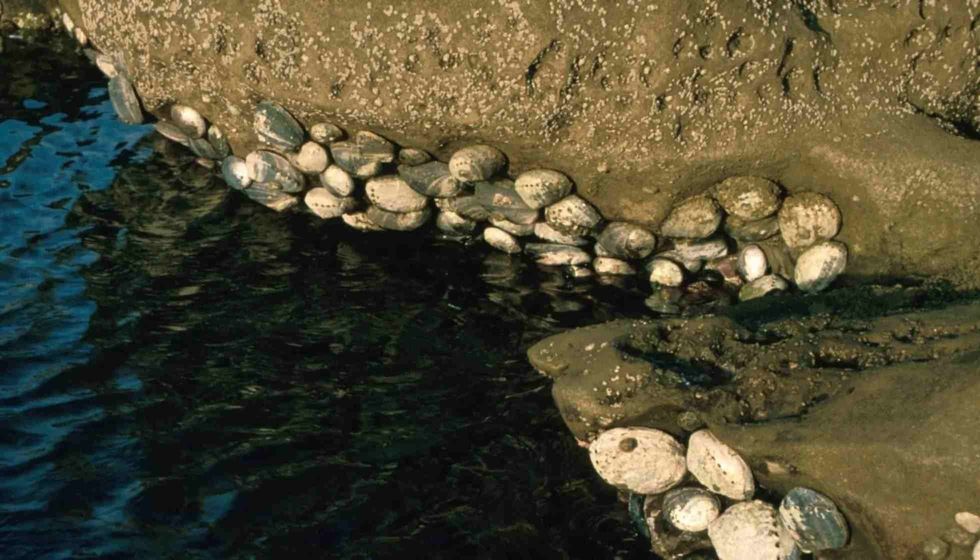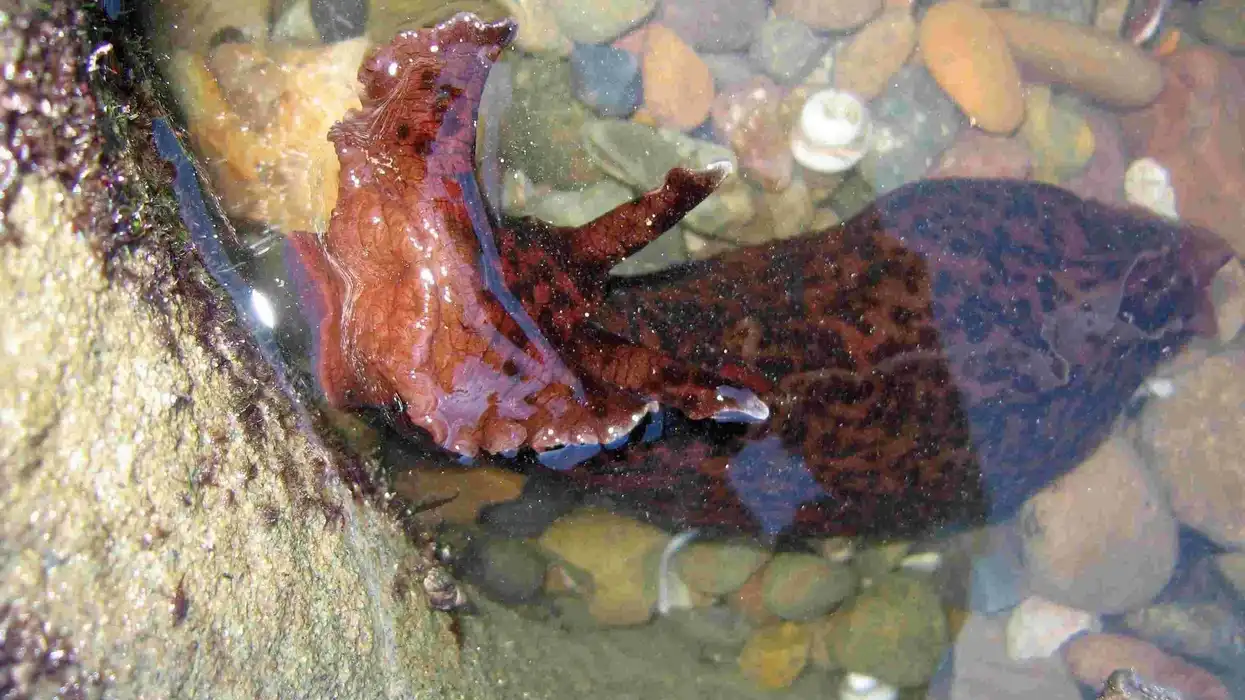Belonging to the genus Haliotis and therefore aptly called the escargot of the sea, abalones are gastropod mollusks considered culinary delicacy the world over, especially in parts of Latin America. Abalones are normally found in the cold waters of Southern California, South Africa, New Zealand, western North America, and the Channel Islands. Abalones are relentlessly hunted.
The mortality rate of the egg and the sperm is approximately 99% due to the fierce ocean currents and unpredictable underwater temperatures. Should the egg actually get fertilized, filter-feeding animals like clams, krill, and sponges lie in wait.
If the odds are beaten still, and the larva matures into a juvenile, nocturnal predators like crabs, lobsters, and octopuses await them in the dead of the night. You would think that when the transition from juvenile to adult takes place, the poor abalone would be safe.
But the biggest plague upon the wild abalone is also the plague devastating the rest of the planet. Mankind. Read on for more abalone facts for kids, details about the kingdom, phylum, class, subclass, white abalone, red abalone, and a lot more.
You may also check out the fact files on oysters and conches from Kidadl.
Abalone Interesting Facts
What type of animal is an abalone?
The aforementioned sea snail wild abalone belongs to the Haliotidae family, genus Haliotis and is a univalve mollusk akin to the escargot it is often compared to. The abalone species have evolved complex appendages to prevent predation, like knobs and spines. The geometrical construction that nature has bestowed upon abalone is nothing shy of magic.
The shell of the abalone is seen in a variety of iridescent blue, green, and purple. This sheen, coupled with the exquisite meat makes abalone a very desirable commodity.
The symmetrical, open spiral whorls increase in length exponential rate and begin resembling an ear. They are therefore called ear shells. The last ear shell occupies 90% of the total abalone shells volume.
What class of animal does an abalone belong to?
Abalones belong to the class Gastropoda, which comprises 40,000 species of snails and slugs. They are found in the cold waters of the ocean and on land.
Most gastropods are an essential part of the gourmet cooking industry. They are used for research purposes in early evolutionary studies. They come in all shapes and sizes and genders, some are asexual and some, like, Lymnaea stagnalis, are hermaphrodites.
How many abalones are there in the world?
White abalone, or Haliotis sorenseni, were estimated to have a population of two to four million, back in the 1970s, however, due to excessive and unrestricted fishing norms, only a few thousand white abalones remain. Alas, as the abalone smartens up, so do their predators.
Octopuses and shellfish are replaced by more efficient aggressors like the bat ray and the otter.
The white abalone species faces the threat of extinction within 10 years unless immediate action, especially in terms of fishing restrictions, is taken. Red abalones are another species that exist along with Haliotis tuberculata.
Where does an abalone live?
Abalones are found in the waters of every continent, except for Antarctica.
What is an abalone's habitat?
Living abalones are marine reef dwellers, seeking out rocks near food sources like (kelp and other algae) and crevices to hide within and move about occasionally by virtue of their muscular foot. White abalones are indigenous to the open rock and boulder habitats of the coast of North America.
Black abalones, or Haliotis cracherodii, reside on rocky substrates in intertidal and shallow subtidal reefs of Southern California.
Who do abalones live with?
Abalones are found in clusters.
How long does an abalone live?
An abalone lives anywhere from 25-40 years, with each type of abalone falling somewhere within this spectrum.
How do they reproduce?
Most species of abalone, like the red abalone and white shell abalones, spawn all year round. Low tides for abalone reproduction are preferred.
The males release up to 10 billion sperm and the females release several million eggs at a time. The rate of reproduction as well as the rate of success is directly proportional to the water temperature. However, for those suffering from limited ability, the mating season begins in July and lasts until October.
The sperm and the eggs are released into the ocean at the same time. They are carried by the current until they reach the larvae stage and anchor themselves onto their rocks.
What is their conservation status?
Wild abalones, also called abalones from the rock, are Endangered species.
In North America, sport harvesting of red abalone is permitted. It requires a fishing license, with the daily limit set at three per diver and a minimum abalone shell length of 7 in (180 mm).
Paua, as it’s called in New Zealand, is harvested recreationally, with the daily limit being 10 per diver with a minimum abalone shell length of 5 in (125 mm).
The problem of illegal abalone poaching for commercial harvest in South Africa is worse than ever before, and wild abalone has replaced ivory for the title of white gold.
Abalones Fun Facts
What do abalones look like?

Abalones spark delight and appetite for anyone who gazes upon their beauty. Perfectly polished by the forces of nature, abalones resemble clams and other mollusks.
Nevertheless, their specular hues of the colors of the rainbow, coupled with the effect saltwater has on their calciferous abalone shell, fragment sets them apart from their contemporaries. Should the stars align and the goddess of fate look kindly upon the receiver of her blessings, pearls are formed. Talk about god giving with both hands.
Red abalones are another species that exist along with Haliotis tuberculata.
How cute are they?
While they do not shatter the cuteness records set by golden retrievers puppies or teacup pigs, abalones are exquisite creatures, especially when they produce pearls in their shells. Abalone shell gems fall under the same category as amber and pearl.
Abalone shell fragments are repurposed and attached to lockets and other charms. But, as they say, beauty lies in the eyes of the beholder.
How do they communicate?
Little to no data is available on abalone communication, but they share a symbiotic relationship with sea urchins in the hopes of avoiding predators. Therefore, it is safe to say that they are not completely socially awkward.
How big is an abalone?
The size of the members of the family Haliotidae varies from the runt of the litter, Haliotis pulcherrima, and Haliotis rufescens, the behemoth. The former is just 0.8 in (2 cm) tall while the latter is 12 in (30.4 cm) tall. The largest abalone species pales in comparison to the largest calm species which is four times its size.
How fast can an abalone move?
Unsurprisingly, abalones are not the spitting image of agility and spend their time choosing to lay idle on their rock. But by virtue of their muscular foot, juvenile abalones can move few dozen feet in a single day. However, the movement of abalone becomes more restricted as they grow.
How much does an abalone weigh?
The weight is dependent largely upon the species, but fully grown abalone weigh about 10.5 oz (300 g).
What are the male and female names of the species?
All members of the family Haliotidae are called abalones.
What would you call a baby abalone?
Abalone larvae are called spat. As they grow, they are called juveniles.
What do they eat?
Abalones, like sea urchins, serve the ecological system by controlling the algae population. Due to storms during the winter, algae are torn apart, and the abalone feast on them using their rasping tongue called a radula.
They eat red and green algae in the wild and a fed a variety of kelp in commercial fisheries. Larvae are fed microalgae and settled onto a hatchery plate, which is akin to an artificial reef. When the spat transforms into juveniles, microscopic diatoms.
Are they poisonous?
The meat of the abalone is completely safe for consumption, but the dust created by grinding the shell is indubitably toxic.
Would they make a good pet?
No, abalones would not make a good pet for a number of reasons. First, they are sedentary creatures and will not provide any entertainment or affection.
Second, they require a tremendous amount of upkeep and while they do provide a certain aesthetic to the aquarium, it is not worth the hassle. Third, abalones live up to 40 years. Therefore, the odds that they outlive you are considerable.
But these are trivial discouragements. The third and most important reason that abalones would not make good pets is that they are endangered and face the threat of extinction within ten years.
Did you know...
The Maori, native to the island of New Zealand, believe luck, joy, and prosperity come to those who wear abalone jewelry or articles.
Can you eat abalones?
Yes, you can eat abalones. In fact, the entire gourmet food industry encourages you to.
Abundantly reared on the west coast of North America, New Zealand, South Africa, Australia, China, and Japan, abalone meat is an essential component of all seafood courses in fine dining. Abalones are served as entrees as a precursor to the main course as they stimulate appetite and also act as an aphrodisiac.
So should you choose to splurge on yourself and your significant other one fine day, abalones will only further your cause and make the evening all the more enjoyable. Raw meat of abalone is a staple in Japanese Ezo Awabi.
Abalone tastes like a divine cross between foie gras and scallops. Imbibed in abalone is the saline crisp of the ocean and a buttery texture that elevates its umami tenfold and provides it with a unique tenderness often missing from seafood.
What is abalone used for?
Abalone is a true culinary delicacy, partly because of its exquisite taste and unprecedented richness and partly because of the danger the species is in. Abalones are also used in the jewelry sector, for their shell to be converted into ornaments and charms akin to those made out of amber or pearl.
Both the interior and the exterior of the shell are used. They provide their wearers with a distinctly organic feel, absent in diamond or gold.
The abalone shell is used to burn sage in some native American cultures.
The people who believe in the psychic powers of ancient organic gemstones swear by the trinkets fashioned from abalone shells. They claim that it raises their intuition and provides them with tranquility and peace, especially in times of spiritual or emotional turmoil.
Here at Kidadl, we have carefully created lots of interesting family-friendly animal facts for everyone to discover! For more relatable content, check out these blue sea slug facts and knobbed whelk facts for kids.
You can even occupy yourself at home by coloring in one of our free printable Abalone coloring pages.










